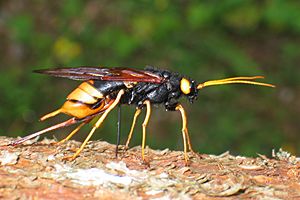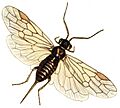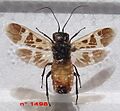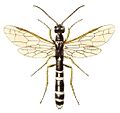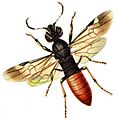Sawfly facts for kids
Quick facts for kids SawflyTemporal range: Triassic – Recent
|
|
|---|---|
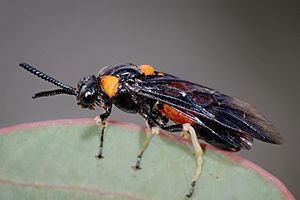 |
|
| Melaleuca | |
| Scientific classification | |
| Kingdom: | |
| Phylum: | |
| Class: | |
| Order: | |
| Suborder: |
Symphyta
|
Sawflies are insects that belong to the same group as ants, bees, and wasps. They get their name from the female's special saw-like tool, called an ovipositor. She uses this tool to cut into plants where she lays her eggs. There are about 8,000 different types of sawflies known around the world.
Unlike bees and wasps, adult sawflies do not have a "wasp waist." This means their body is wide where their middle section (abdomen) connects to their chest (thorax). Some sawflies look a lot like wasps or bees, which helps protect them from predators. Their ovipositor can sometimes be mistaken for a stinger, but sawflies do not sting. Most sawflies are small, usually from 2.5 mm to 20 mm long. The biggest known sawfly was about 55 mm long. Baby sawflies, called larvae, look like caterpillars. However, you can tell them apart by counting their leg-like parts (prolegs) and checking for tiny hooks (crochets) that caterpillars have but sawfly larvae do not.
Most sawflies eat plants. But some, like those in the Orussoidea group, are parasitoids. This means their larvae live on or inside other insects and eat them. Birds, other insects, and small animals like to eat sawflies. Some sawfly larvae have cool ways to protect themselves. They might spit out a liquid that tastes bad or gather in big groups to look more threatening. Sawflies are also often hosts for tiny wasps and flies that lay their eggs on them.
Contents
Life Cycle
Adult sawflies do not live very long, usually only about 7 to 9 days. But their larval stage can last much longer, from a few months to several years, depending on the type of sawfly. Many female sawflies can lay eggs without needing a male to fertilize them. This is called parthenogenesis. Adult sawflies eat things like pollen, nectar, and plant sap.
Sawflies go through a complete change in their life. They have four main stages: egg, larva, pupa, and adult. The female sawfly uses her saw-like ovipositor to cut into plants (or other insects for parasitic types) and lays her eggs in groups.
After the eggs hatch, the larvae start eating plants. They often feed together in groups. When they are almost ready to become adults, the larvae find a safe place to rest and change. This is usually in tree bark or in the soil.
Appearance
Many sawflies still look similar to their ancient ancestors. They still eat plants, have specific wing patterns, and their body sections are not changed much. The main way to tell a sawfly from other insects in its group, like wasps, is that sawflies do not have a narrow "wasp waist." Some sawflies copy the colors of wasps and bees to trick predators. Their egg-laying tool might look like a stinger, but sawflies cannot sting. Most sawflies have soft bodies and are not very strong flyers.
Sawflies come in different sizes. For example, the Urocerus gigas, which looks like a wasp with its black and yellow stripes, can grow up to 20 mm long. The largest sawfly ever found was Hoplitolyda duolunica, which was 55 mm long with a wingspan of 92 mm. The smallest sawflies are only about 2.5 mm long.
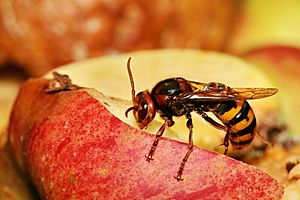
Sawfly larvae are often mistaken for caterpillars. However, there are a few key differences. Both have three pairs of legs near their head and a pair of leg-like parts at their tail end. But caterpillars usually have four more pairs of leg-like parts in the middle of their body, while sawfly larvae have five pairs. Caterpillars also have tiny hooks on their leg-like parts, which sawfly larvae do not. Also, sawfly larvae only have one tiny eye on each side of their head, while caterpillars have four to six. Sawfly larvae move and eat leaves just like caterpillars. Some types of larvae live inside plants or wood and do not have eyes or many legs. Many sawfly larvae have bright colors like black and white or black and yellow. These colors are a warning to predators because some larvae can release irritating liquids from their bodies.
Distribution
Sawflies live all over the world. The biggest family of sawflies, the Tenthredinidae, has about 5,000 different types. You can find them on every continent except Antarctica. They are most common in cooler parts of the northern half of the world. The next biggest family, the Argidae, has about 800 types and is also found worldwide, but especially in Africa. Other sawfly families live in specific regions, like Europe, Asia, or North America. The parasitic Orussidae sawflies are found mostly in warm, tropical areas.
Sawflies and Humans
Large groups of certain sawfly species, like the pine sawfly, can cause a lot of damage to trees used for wood. Other types, like the iris sawfly, are common pests in gardens. When many sawfly larvae eat leaves, they can strip trees bare. This can make trees grow slowly, get sick, or even die. People can control sawflies using special sprays (insecticides), by encouraging their natural enemies (like birds or other insects), or by removing them by hand.
History and Evolution
Sawflies are very old insects. They first appeared about 250 million years ago, during the Triassic period. The oldest group of sawflies, the Xyeloidea, still exists today. More than 200 million years ago, some sawflies started living as parasites, with their larvae eating the eggs or young of other insects.
Images for kids
-
Anti-predator adaptation: spitfire sawfly larvae grouped together for safety
-
Caterpillar-like larvae of Iris sawfly on yellow flag plant, showing damage
See also
 In Spanish: Symphyta para niños
In Spanish: Symphyta para niños



